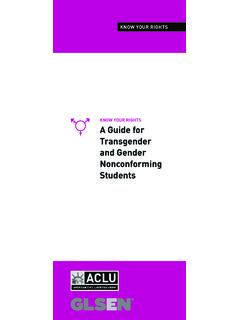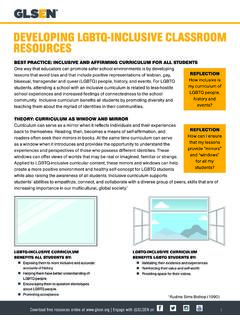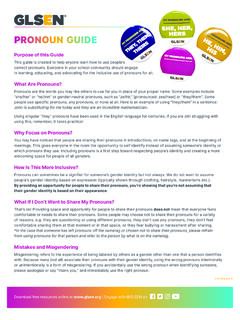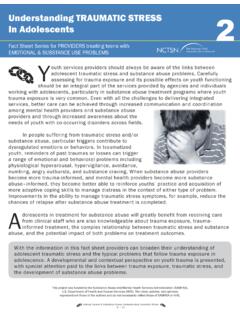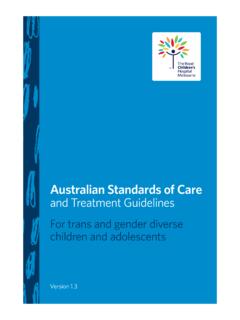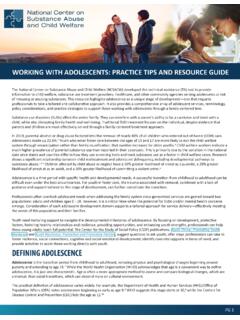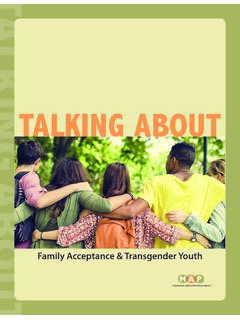Transcription of PRONOUNS: A RESOURCE - GLSEN
1 PRONOUNS: A RESOURCE SUPPORTING transgender AND GENDER NONCONFORMING (GNC) EDUCATORS AND STUDENTS Why focus on pronouns? You may have noticed that people are sharing their pronouns in introductions, on nametags, and when GSA meetings begin. This is happening to make spaces more inclusive of transgender , gender nonconforming, and gender non-binary people. Including pronouns is a first step toward respecting people s gender identity, working against cisnormativity, and creating a more welcoming space for people of all genders. How is this more inclusive? People s pronouns relate to their gender identity.
2 For example, someone who identifies as a woman may use the pronouns she/her. We do not want to assume people s gender identity based on gender expression (typically shown through clothing, hairstyle, mannerisms, etc.) By providing an opportunity for people to share their pronouns, you're showing that you're not assuming what their gender identity is based on their appearance. If this is the first time you're thinking about your pronoun, you may want to reflect on the privilege of having a gender identity that is the same as the sex assigned to you at birth. Where do I start? Include pronouns on nametags and during introductions.
3 Be cognizant of your audience, and be prepared to use this RESOURCE and other resources (listed below) to answer questions about why you are making pronouns visible. If your group of students or educators has never thought about gender-neutral language or pronouns, you can use this RESOURCE as an entry point. What if I don t want to share my pronouns? That s ok! Providing space and opportunity for people to share their pronouns does not mean that everyone feels comfortable or needs to share their pronouns. Some people may choose not to share their pronouns for a variety of reasons, they are questioning or transitioning their pronouns, they don t use or like any pronouns, they don t feel comfortable sharing them at that moment or in that space, or they fear bullying or harassment after sharing.
4 In the case that someone has left pronouns off the nametag or chosen not to share their pronouns, please refrain from using pronouns for that person and refer to the person by name. Misgendering Misgendering refers to the experience of being labeled by others as a gender other than one that a person identifies with. The essential thing to do after learning someone s pronouns is remembering to use those pronouns when referring to that person. If you accidentally use the wrong pronoun when identifying someone, please correct yourself in front of that person and begin using the right pronoun.
5 Everyone makes mistakes, and making visible your work to respect and use someone s pronoun after a mistake is an important moment to take. It is not the responsibility of the transgender or GNC person to address your feelings after misgendering. What about PGP? There has been a shift away from the term preferred gender pronoun or PGP to using pronoun. This change was made because a person s pronouns are not just preferred; they're the pronouns that must be used. Make your support visible! Include pronoun: under name: in nametags and introductions as an opportunity for participants to make visible their gender pronouns.
6 Put up a sign or statement like this near the nametags, classrooms, or GSA meeting spaces: [Your School or Group Name] is including pronouns because we are working to make our spaces more inclusive of transgender , gender nonconforming, and gender non-binary people. Put up this sign near nametags with pronoun sections: We encourage you to fill in the pronoun section along with your name, so that we use the correct pronouns with each other from the beginning. We have left the pronoun section blank so that you can fill in any/all pronouns you use. Wear and distribute pronoun buttons or nametags at school.
7 Tips for Gender-neutral Language: If you feel comfortable, introduce yourself with your pronouns as a model. For example: Hi, I m Anjelique. I use she/her and they/them pronouns or I m Milo, and I use they/them pronouns. Practice, practice, practice! Use gender-neutral pronouns such as they and ze while visualizing the person who uses them. Whenever possible, take the lead from the transgender and GNC students and educators in your school, especially during the planning stages. Welcome feedback, and be ready to make adjustments as you continue to make your spaces more inclusive: If you have any feedback for us on how to make this GSA a more welcoming space for transgender , gender nonconforming and gender non-binary people, please let us know!
8 When addressing groups of people or people whose pronouns you haven t been told, use gender-neutral language such as, friends, folks, all, or y all, rather than guys, ladies, ma am, or sir. Other resources from GLSEN for supporting Trans/GNC Youth Webinar for Educators: Supporting Trans and GNC Students Be a Better Ally to Trans and GNC Youth Know Your Rights: A Guide for transgender and GNC Students Video on genderfluidity by one of GLSEN 's National Student Council members Blogs on nonbinary identity and transgender binary-privilege Make your GSA more Trans and GNC Inclusive Leading Organizations for transgender Advocacy.
9 National Center for transgender Equality transgender Law Center - Trans Student Educational Resources (TSER) - Trans Women of Color Collective - IMPORTANT TERMS: Cisgender: A person whose gender identity and expression are aligned with the gender they were assigned at birth. Cisnormativity: The assumption that cisgender identity is the norm, which plays out in interpersonal interactions and institutional privileges that further the marginalization of transgender people. Gender: A set of cultural identities, expressions and roles codified as feminine or masculine that are assigned to people based upon the interpretation of their bodies, and more specifically, their sexual and reproductive anatomy.
10 Since gender is a social construction, it is possible to reject or modify the gender one is assigned at birth, and to develop, live and express a gender that feels truer and just to oneself. Gender Binary: A socially constructed system of viewing gender as consisting solely of two categories, male and female, in which no other possibilities for gender are believed to exist. The gender binary is a restrictive and inaccurate way to view gender because it does not take into account the diversity of gender identities and gender expressions among all people. The gender binary is oppressive to anyone that does not conform to dominant societal gender norms.
